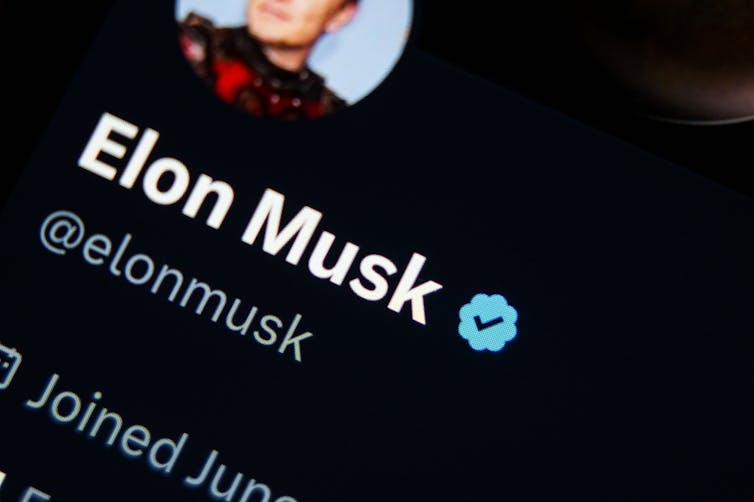X, formerly known as Twitter, is testing a subscription plan called “Not a Bot” of US$1 equivalent per annum in New Zealand and the Philippines. Those who don’t subscribe will still be able to log in to view content and follow other accounts, but won’t be able to interact through tweeting, liking, sharing or bookmarking content. The plan is limited to new accounts and only the browser version of the platform, as opposed to the mobile app.
As the name of the plan suggests, X has positioned Not a Bot as a means to deter bots. Bots are fake accounts running on automated scripts, usually created by malicious actors to spread fake news and drive advertising traffic. They are present in large numbers not just on X but also other platforms such as Facebook.
Bots have been a dominant theme since Musk took charge of Twitter a year ago. His troubled move to start charging for blue checkmarks was part of the same battle, while he also previously tried to get out of buying the company on the grounds that the previous board hadn’t been clear with him about bot levels. Introducing a broader system of charges to tackle bots is a bold move, but there’s a good chance it will only make the company’s problems worse.
The bot arms race
Ever since the Musk takeover, X’s financial woes seem to have only increased. Despite aggressive layoffs of thousands of employees and a sharp reduction in server capacity, the company has yet to reach positive cashflow (though new CEO Linda Yaccarino has said breakeven is close). This is because its revenues have shrunk as fast, falling approximately 59% in the year to May as advertisers have exited due to increased hate speech and ads featuring things like online gambling and marijuana products. This, combined with the increased debt burden from the takeover, has put X under serious pressure to achieve a turnaround.
Internet companies have long been in an arms race with bot makers. Every time they implement a new means of detecting fake accounts, bot makers find ways of countering them. Older bot-detection algorithms sought to purge internet platforms using machine learning and searching for unusual language patterns, but weren’t particularly successful.
Things have gotten worse with the rise of generative AI. It has literally changed the face of fake news, videos and images, reducing the ability to detect bots either through algorithms or even human moderators.

Musk’s US$1/year proposal represents a different approach. The main problem is bot farms, where thousands of accounts are created and then run on different social media platforms via large servers. This makes it possible through economies of scale to create a bot account for a fraction of a penny, according to Musk. By charging new X accounts, it will become much more expensive for bot farms to achieve the scale needed to be profitable.
Restricting the charge only to the browser version of X will hurt them the most: whereas the mobile app only allows a single account login at a time, bot accounts need multiple logins on different browser windows running on the same machine to be useful.
A decent idea in theory …
On the face of it, the proposal sounds a smart move. Having fewer bots may help X win back some of the advertisers who have quit the platform.
It is also a new revenue stream. Musk said shortly after his takeover that X was signing up 2 million new accounts per week, which points to some potential, but let’s not get carried away. It is unclear how many genuine users will agree to pay the charge, but since browsers account for approximately 20% of the monthly total active base, we could assume a generous 10% of new subscribers. This would result in a paltry US$10.4 million (£8.6 million) increase in annual revenues, less than 0.25% of the company’s 2022 total.
This also has to be offset against potential users deciding to walk away. Particularly if the scheme becomes more aggressive in size and scope, it could become the undoing of the platform. Musk has already hinted at charging all X users a small monthly fee. Supposing it were US$1 per month, it could prompt a steep drop not only in bots but in genuine users.
Let’s not forget the chaos around Musk’s blue check mark subscription, for which lots of celebrities refused to pay and the platform partially backtracked to prevent an exodus. That system also didn’t stop malicious actors from scamming genuine X users. With X users already having felt the whiplash of Musk’s previous decisions, charging them for what has been free could be the straw that breaks the camel’s back.

To emphasise, a platform’s value lies in its user base. The more users interact with each other, the more content they produce and vice versa. This induces other users to join the platform, which makes it attractive to advertisers who can reach a bigger, more engaged audience. This virtuous cycle is known as “network effects”, and drives the success not only of social media but also services like telecoms, ride sharing, messaging, streaming and multiplayer online games.
High risk, low return
While bots are a very real issue, X’s “bot tax” is not the best way forward. This is akin to a government raising taxes on tax-paying citizens because it is incapable of getting tax avoiders to pay their share.
Unfortunately there’s no quick fix with bots. The best way forward is leveraging advanced technologies such as generative AI, sharing more transparent data with academic institutions to push research forward, and sharper human moderation.
X needs to remain in that arms race, while sticking to the broader reinvention strategy already outlined by Musk. This includes turning X into a super-app, akin to WeChat, Grab and others from Asia, offering new services such as telephony, remittances, deliveries, mini games and video channels. Giving users more things to do in one place is key to the platform’s future. But that requires more patience and cash, which both X and Musk might be running out of.
![]()
Hamza Mudassir does not work for, consult, own shares in or receive funding from any company or organization that would benefit from this article, and has disclosed no relevant affiliations beyond their academic appointment.



